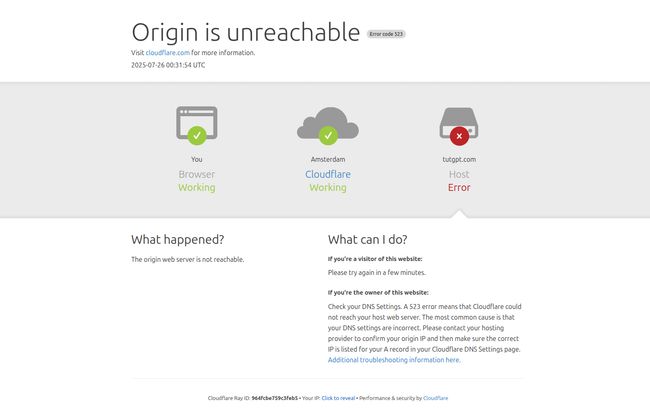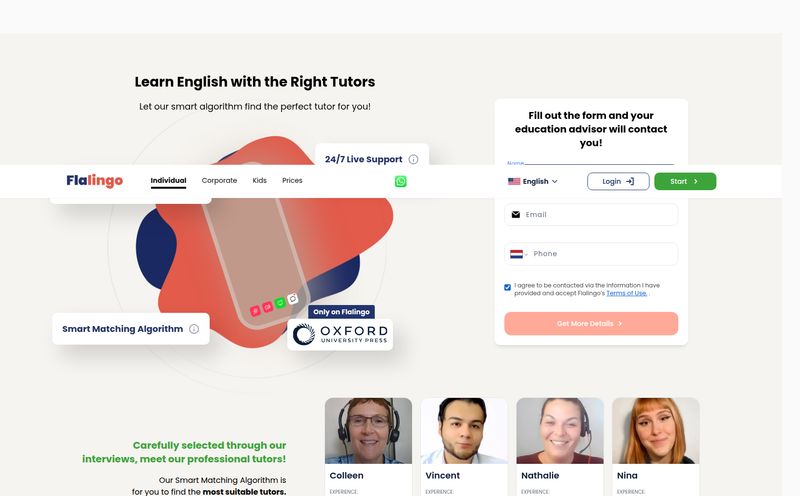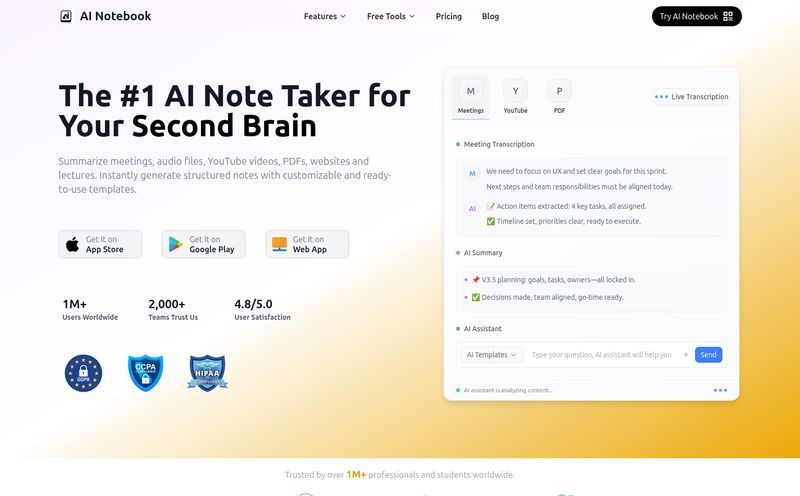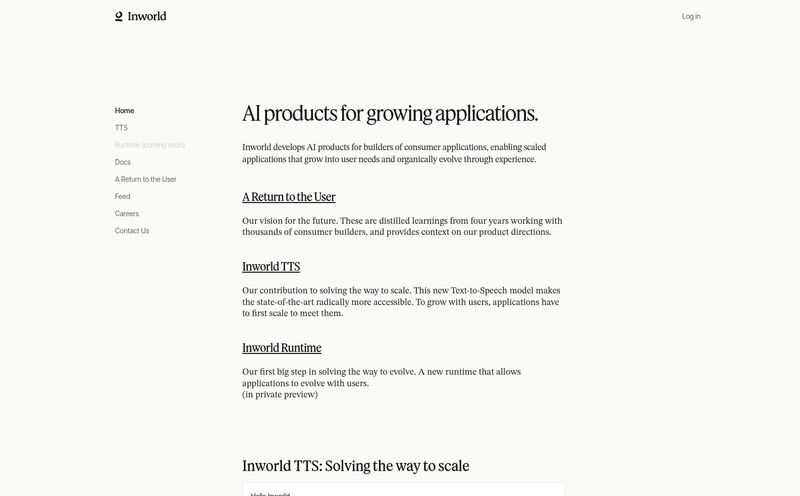If you run any kind of online business, you know the feeling. The constant barrage of the same questions flooding your inbox. "Where's my order?" "How does feature X work?" "What's your refund policy?" It's a never-ending game of customer support whack-a-mole, and frankly, it can drain the life out of you and your team.
For years, we've been looking for the holy grail: automated, intelligent support that doesn't feel... well, robotic. Enter the new wave of custom AI chatbots. And today, we're looking at a contender in this crowded space: TutGPT.
Now, full disclosure, as I'm writing this, I've hit a bit of a snag. It seems TutGPT's website is taking a little nap (I'm seeing a Cloudflare 523 error). It happens to the best of us! Every startup has those days. But it won't stop us from digging into what this tool promises, because the concept is just too interesting to ignore.
So, What Exactly is TutGPT Supposed to Be?
Imagine you could hire an employee, sit them down with all your company documents, your website pages, your help guides, and your product descriptions. And within minutes, they've memorized it all and are ready to answer any question with perfect accuracy, 24/7. That's the core idea behind TutGPT. It’s a platform that lets you build a custom ChatGPT-powered bot trained exclusively on your content.
This isn't your average, clunky chatbot that can only point people to a generic FAQ page. This is about creating a knowledge expert for your brand. You feed it your business's brain, and it becomes a tireless assistant for your customers or even your own internal team. Need to find a specific clause in a company policy doc? Ask the bot. A customer has a niche question about a product? The bot's got it. It's a pretty compelling pitch.
Breaking Down the Core Features
From what I've gathered, the platform is built around a few key functionalities. It's not about overwhelming you with a million buttons but focusing on getting the job done.
Feeding Your AI Brain
The whole system hinges on the data you provide. TutGPT lets you do this in a couple of straightforward ways. You can simply give it a list of URLs from your website, and it'll crawl and index that content. Or, you can directly upload documents—think PDFs of manuals, Word docs of policies, and so on. This flexibility is nice because not all business knowledge lives on a public webpage.
Making the Chatbot Your Own
Nobody wants a generic-looking widget on their beautifully designed website. TutGPT offers a customizable chat widget that you can embed right onto your site. The goal is for it to feel like a native part of your user experience. And, as we'll see in the pricing section, you can even remove their branding on the higher-tier plan, which is a must-have for established businesses.
A Glimpse of the Future: YouTube Integration
This one is listed as "coming soon," and it's a feature I'm genuinely excited about. The ability to index content from YouTube videos would be huge. Think of all the tutorials, webinars, and product demos you could make instantly searchable. A customer could ask, "How do I tighten the widget?" and the bot could pull the answer directly from a timestamp in a video tutorial. It's not here yet, but it's a promising sign of where the tool is headed.
How This Actually Helps Your Business
Okay, features are cool, but I'm an SEO and traffic guy. I care about results. So how does a tool like this translate into tangible benefits?
First, there's the obvious time and money savings. Every question the bot answers is one less ticket a human has to handle. This frees up your support team to focus on the complex, high-touch issues where a human connection really matters. That's not just a cost-saver; it’s a morale booster.
Then there's the customer experience. In our on-demand world, waiting 24 hours for an email response feels like an eternity. Providing instant, accurate answers builds trust and reduces friction, which can directly impact conversions. A happy, informed visitor is much more likely to become a customer.
And let's not forget internal productivity. I've worked in companies where finding a simple piece of internal information felt like an archaeological dig through shared drives. A TutGPT bot trained on your internal documentation could become the go-to source for your own team, getting new hires up to speed faster and saving everyone time.

Visit TutGPT
The All-Important Question: What's the Price?
Alright, let's talk turkey. A tool is only as good as its accessibility, and price is a huge part of that. TutGPT has a pretty clear tiered structure, which I appreciate. No confusing credits or weird pricing models.
| Plan | Price | Key Features |
|---|---|---|
| Starter | $19 /month | 1 Bot, 1k Source Pages, 1k questions/mo, 1 user |
| Pro | $49 /month | 3 Bots, 5k Source Pages, 5k questions/mo, 1 user, Advanced Analytics, Chat history |
| Business | $99 /month | 10 Bots, 10k Source Pages, 10k questions/mo, 5 users, Unbranded widgets, Prompt customization |
The Starter plan feels right for a solopreneur or a small site just dipping its toes in. The Pro plan, in my opinion, is the sweet spot for many growing businesses. The addition of analytics and chat history is huge—you need to see what people are asking to improve your content. The Business plan is for serious teams. Getting to remove the branding and add multiple users is non-negotiable at a certain scale.
The Bumps in the Road
No tool is perfect. And it's important to go in with your eyes open. The most obvious issue, at this very moment, is the site outage. It's a stark reminder that when you rely on a SaaS tool, their uptime is your uptime. Hopefully, it's just a temporary blip.
The other main limitation is the source page limits. 1,000 pages on the Starter plan sounds like a lot, but if you have a large blog or extensive documentation, you could hit that ceiling faster than you think. You'd need to be strategic about which URLs you feed it. And of course, the hyped YouTube feature is still just a promise. If video is your primary content format, you'll have to wait.
So, Who Should Give TutGPT a Shot?
Based on its feature set and pricing, TutGPT seems best suited for small to medium-sized businesses, content creators, and e-commerce stores who have a solid base of written documentation or website content. If you're constantly answering the same questions and want to offer a better, faster support experience without hiring a whole new team, this is exactly the kind of tool you should be investigating.
Who might want to hold off? Large enterprises with complex CRM integration needs might find it a bit too simple. And, as mentioned, anyone whose entire knowledge base is locked away in video format should probably wait until that feature goes live.
Final Thoughts
Despite the current website hiccup, I'm optimistic about what TutGPT is trying to do. The world of AI is moving at a breakneck pace, and tools that apply this powerful technology to solve a real, everyday business problem are always going to catch my eye. The pricing is reasonable, and the proposition is clear: save time, help customers faster, and make your business knowledge instantly accessible.
I’ll definitely be checking back on their site. If they can deliver on their promises and maintain a stable platform, TutGPT could be a fantastic, no-fuss addition to a business’s toolkit. It’s like getting a new, incredibly smart employee for less than the cost of a few cups of coffee a day.
Frequently Asked Questions
- How is TutGPT different from just using the regular ChatGPT?
- The key difference is the data source. Regular ChatGPT has broad, general knowledge from the internet. A TutGPT bot is trained specifically on your business content, so it can answer questions about your products, policies, and services with precision.
- Is it hard to install TutGPT on a website?
- It's designed to be simple. Typically, tools like this provide a small snippet of code (an embeddable widget) that you can copy and paste into your website's HTML. No deep coding knowledge is usually required.
- Can I remove the 'Powered by TutGPT' branding?
- Yes, you can. This feature, often called an 'unbranded widget', is available on the Business plan for $99/month. This is important for maintaining a consistent brand experience on your site.
- What happens if I go over my monthly question limit?
- Since the site was down, I couldn't confirm their specific overage policy. Generally, SaaS companies will either temporarily pause the service, prompt you to upgrade your plan, or charge a small fee for extra usage. It's best to check their terms once the site is back online.
- Does TutGPT offer a free trial?
- The pricing information I found didn't explicitly mention a free trial. However, many SaaS platforms do offer one or a money-back guarantee. This would be another thing to verify directly on their website.
Reference and Sources
- TutGPT Official Website: tutgpt.com (Note: Experiencing technical difficulties at the time of writing)
- Explanation of the Error 523: Cloudflare Learning Center



